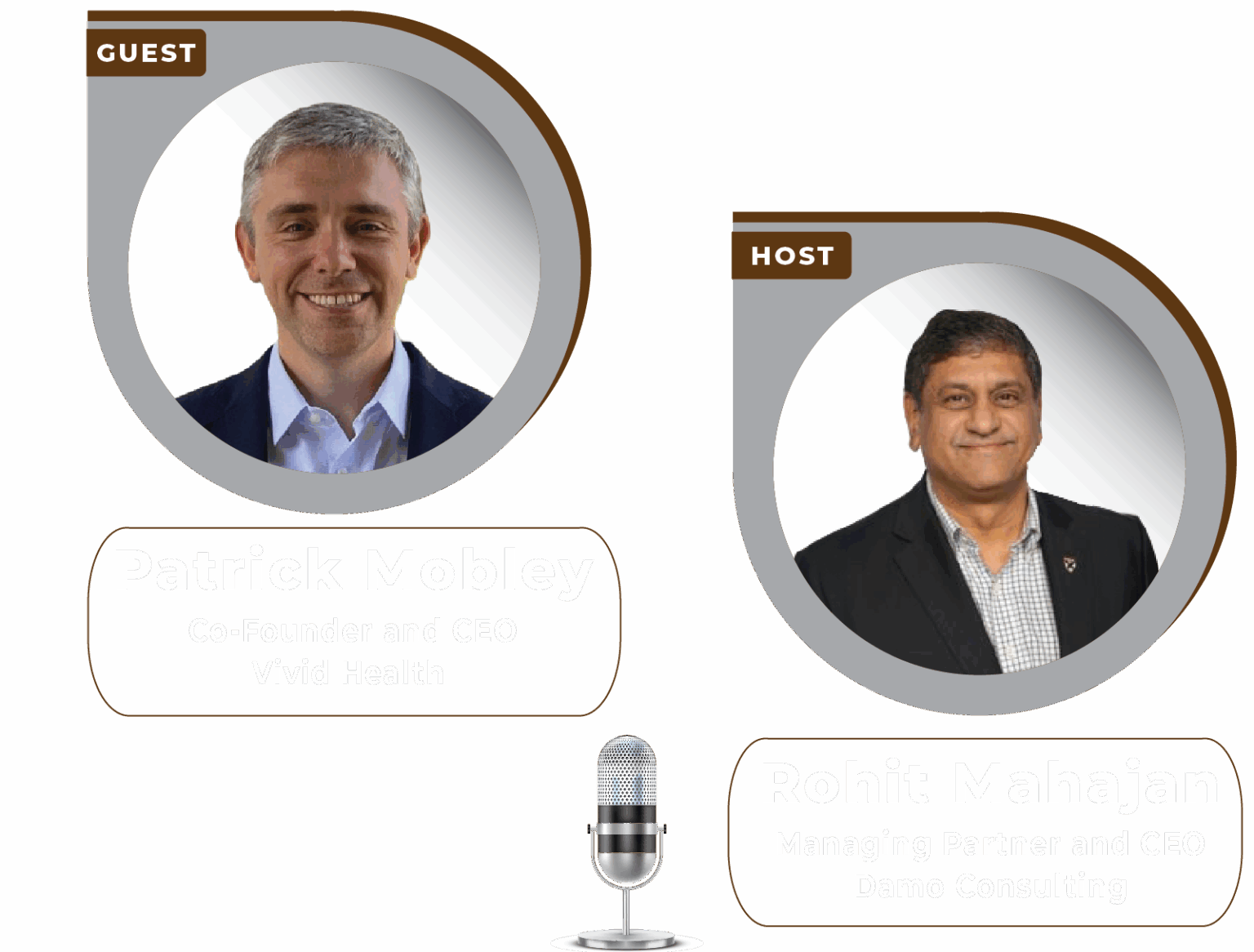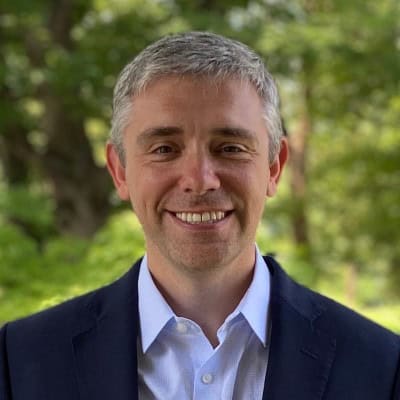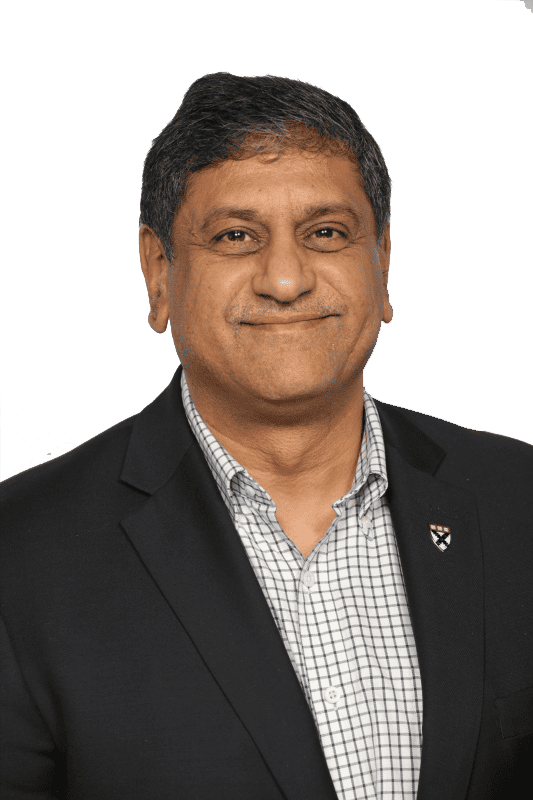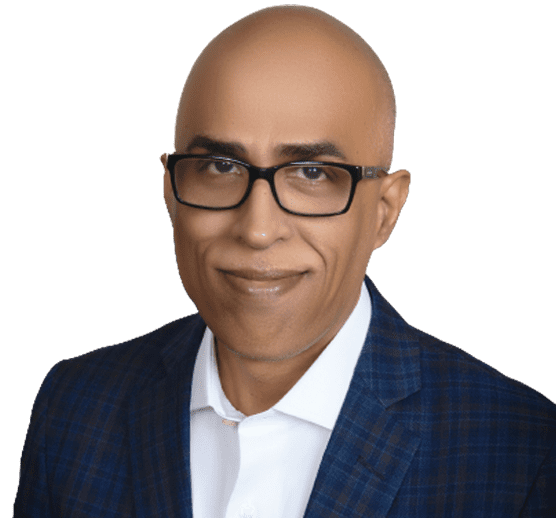Season 6: Episode #164
Podcast with Patrick Mobley, Co-Founder and CEO, Vivid Health

Share
In this episode, Patrick Mobley, Co-Founder and CEO at Vivid Health shares how his personal background and professional journey inspired him to launch a platform that improves clinical workflows using generative AI.
Built in collaboration with Redesign Health, Vivid Health’s platform is designed to automate time-consuming, manual processes, such as patient outreach, assessments, care planning, and follow-ups—freeing nurses and care teams to focus on providing care. Patrick highlights their “provider-led AI” approach, where providers retain final control over AI-generated outputs. The platform supports over 100 conditions across 16 specialties and is being adopted in primary care, home health, and hospice settings. It reduces documentation time by over 50% and eliminates outreach labor in chronic care management workflows.
Patrick also emphasizes the platform’s value in scaling care, improving patient engagement, and supporting revenue generation, while offering deeper, more honest insights through automated, holistic patient assessments. Take a listen.
Show Notes |
||||
| 01:14 | What interests you in the healthcare industry segment to become the CIO of a hospital system? | |||
| 02:47 | How long have you been in the leadership position at UMC, where is it located, and what kind of population does it serve? | |||
| 03:35 | You have done a lot of work from technology perspective to support the business needs of the hospital. You've done over 200 applications and transformed the EMR system. Would you like to share with the audience the thought process that drove those changes and what were some of those changes? | |||
| 07:47 | What do you think about your digital transformation efforts? If you could describe a few of them which have had impact on the patient population. | |||
| 08:30 | Please describe in your own, you know, way that what is digital transformation for provider systems such as yours? Where do you see it going? Some of the challenges that you might have faced and how did it actually end up impacting patients? | |||
| 11:24 | How did you manage to change the mindset of the people? How did they manage to change themselves? To adapt to this new world where technology, especially with AI and GenAI and other new technologies which are coming our way, how do you change mindsets and change behaviors and change culture over there? | |||
| 13:00 | Would you like to provide one example of how the technologies which you were implementing, and you continue to be implementing in your hospital system are accessible and usable by a variety of users, including within the hospital and outside the hospital. | |||
| 16:28 | How do you innovate? Do you involve external parties? Do you have some kind of a, you know, innovation focus department? Or is it part and parcel of everybody's, you know, kind of like daily life? | |||
| 19:24 | What are your thoughts on new technologies, especially Gen AI? Have you been experimenting with any predictive analytics or large language models? What would be your advice or thoughts to any other healthcare leaders on how to go about this journey of exploration? | |||
| 22:15 | Standing here now and looking back, if you were able to go back and change one or two things, what would you like to do differently or have done differently? | |||
Video Podcast and Extracts
About Our Guest

Patrick is Founder and CEO of Vivid Health, a generative AI care management platform serving risk-bearing providers, payers, and post-acute facilities. He previously served as President of the Mid-Atlantic for Bright Health, where he led one of the nation's largest exchange plans, growing membership by over 500% within two years.
Prior to Bright, Patrick led Aledade’s largest national market in North Carolina, guiding independent providers in adopting value-based care strategies and expanding the local value-based care network by over 200% within 10 months. His executive experience also includes several senior roles at Evolent Health: as Market President for Virginia, he managed one of the nation's largest full-risk ACOs; as Managing Director for Payer Partnerships, he oversaw the company's entire value-based care portfolio; and as Senior Director for Business Innovations, he led new market implementations nationwide. Patrick's career began in consulting, working with Deloitte and Grant Thornton, among other firms. He earned a degree in Psychology with a minor in Public Policy from the University of North Carolina at Chapel Hill, and holds an MBA from East Carolina University.
Recent Episodes
Q. Hi Patrick, welcome to the Big Unlock podcast. Great to have you with us today. I’m Rohit Mahajan, Managing Partner and CEO of BigRio and Damo Consulting. The Big Unlock podcast was started by Paddy Padmanabhan, founder of Damo Consulting, and it’s been a successful series with many healthcare leaders. Great to have you here.
Would you like to introduce yourself to the audience?
Patrick: Sure. I’m Patrick Mobley, CEO and founder of Vivid Health. A bit about my background—I’m speaking to you today from Raleigh, North Carolina. I grew up around healthcare; my dad was a physician. I eventually found my way into the startup world. I was an early employee at a company called Evolent Health, where I did a bit of everything. I started on the clinical side, ran their Virginia market, and oversaw value-based care operations.
Then I moved to Aledade, where we aggregated independent providers into shared savings arrangements. We grew from about 20 practices to 220 while I was there. Next, I joined Bright Health and ran a large health plan in the Mid-Atlantic. Across all three companies, I saw what high growth looks like—but I always wanted to build something myself.
Eventually, I connected with the leadership at Redesign Health. I had hired a company that spun out of them. For those who don’t know, Redesign is a venture studio based in New York, backed by General Catalyst, UPMC, CVS, and Aetna, among others. We came up with the idea for Vivid, which really reflects a lot of that experience. I know we’ll get into the details, so I won’t spoil it all now—but it’s really focused on making clinicians’ lives better.
Q. That’s really interesting, Patrick. You’ve had such a deep career in healthcare. What was the early catalyst that set you on this path?
Patrick: As I mentioned, I grew up around my dad’s clinic. It was a very familiar environment.
I saw how hard he worked—the long hours, the behind-the-scenes frustration with paperwork and administrative work. It was inspiring to watch, and it made me want to solve some of those pain points. Thinking I could build something that might help with the things that gave him headaches was definitely exciting.
Q. That is awesome to know. So, you mentioned Vivid already and it came out redesign. So Patrick, please tell us more that. What is your thesis at Vivid Healthcare and and what kind of problems are you solving and what are you working on?
Patrick: In my prior roles before Vivid, I worked closely with nurses or had them report to me. What stood out was how much time it took to call a patient, assess them, build a care plan, and follow up. These are four essential steps in any risk-bearing organization looking to manage cost, high-risk individuals, close care gaps, and improve risk adjustment. I kept thinking—how do we leave the nurses with nothing left to do but provide care? And when I say “nurses,” I also mean LCSWs, community health workers, the whole care team.
So, in partnership with Redesign, we started exploring what generative AI could do—specifically, how we could automate tactical workflows already used in care organizations. That’s exactly what we’ve built: from intake and referral, where an AI agent can call, text, or email a patient, to assessment, care plan generation via a large language model, clinician approval, and automated follow-ups. Whether the patient is with the practice for a day or six months, our platform supports it all.
Q. That’s impressive. What makes the platform so unique? You were also one of the earlier adopters of GenAI in clinical workflows. Was it hard to incorporate? And what results are you seeing now?
Patrick: It definitely wasn’t easy—but we had great partners, like your team at BigRio, to help build it out. We focused on covering a wide range of specialties and conditions. For nurses, it’s about understanding both mental and physical health needs, gathering that data, and turning it into a care plan—while always keeping the provider in control.
In fact, we actually own the trademark for “Provider-Led AI.” We strongly believe that no matter how helpful AI is, the final say should always rest with the clinician. Our platform lets AI agents handle tasks like calling patients, enrolling them in chronic care management, or conducting assessments like OASIS in home health. It builds care plans and allows nurses to focus on care coordination.
One of the most important aspects was making sure we could scale. If we were effective at engaging, assessing, and managing patients up front, then scaling the backend workload was critical. We wanted to amplify our nurses and care teams—individually—but also make sure they weren’t overwhelmed. That’s why we designed the platform to automate follow-ups. The agent can call, text, or email patients. Nurses don’t need to do anything manually. They simply turn on the platform, see patient stratification, view notes from calls, and take action from there. It delivers scale and reach—whether you’re a risk-bearing or home health organization—that you just can’t achieve with any other platform.
Q. So, is that where the positioning of the platform is also Patrick? Tell us a little bit more about who are the kind of potential customers or clients or users of the software platform.
Patrick: Yes. There are a few distinct markets, though I often describe our platform as the perfect puzzle piece for any organization.
One key market is the primary care space. It’s ideal for risk-bearing organizations, but even those that aren’t can still use it to deliver extra care and generate additional revenue.
We can deploy our AI agent to enroll patients in chronic care management, conduct assessments, and complete all required documentation for chronic care, annual wellness visits, and transitional care management. We’re seeing a 100% reduction in outreach specialist labor using our voice AI tool and over 50% cost reduction compared to competitors.
We also target post-acute care—specifically home health and hospice. These settings have some of the most burdensome documentation requirements. In home health, for instance, the OASIS form is 27 pages with 200+ questions. Nurses typically can only see two patients a day because of this.
We’ve automated that entire process. When the nurse enters the home, the OASIS answers are already received, the care plan is generated, and the visit can focus on actual care—not paperwork. We’re seeing over 50% reduction in documentation time, which directly impacts revenue. If a nurse can see even one more patient per day, that’s a significant gain.
Hospice is also going through a big shift to a form called HOPE, which is like a shorter version of OASIS. We’re applying the same technology there and expect similar results.
We currently cover 100 conditions across 16 specialties. That’s generated interest from palliative care providers, non-skilled nursing organizations, and even some specialty groups. Once they see the platform in action, it really resonates. We’re proud of what we’ve built.
Q. That’s amazing, Patrick. And I know you’ve built a robust chronic care management capability across many disease conditions. You also mentioned a bunch of surveys—that’s your proprietary IP, right? So, that is what you built early on the core of the system. So, could you describe that a little bit more in detail on how it adds value and what it actually does?
Patrick: Yes—and there’s a bit of a story there. Many organizations, rightfully, focus on five big conditions like CHF, COPD, diabetes, depression, etc. But I always felt that if a patient has COPD and also a kidney disorder, that second condition could significantly affect their overall health—physically and mentally.
So, we designed our system to evaluate patients across a broad set of conditions, not just a narrow few. We also wanted our surveys to assess both mental and physical health. So we ask questions like, “Do you have chest pain or swelling?” but also, “Do you have anxiety about paying for your meds?” or “Do you have transportation and social support?”
This creates a holistic view of the patient. The feedback we’ve received is that when patients interact with a clinician directly, they may feel pressure to answer a certain way. But when we deliver the assessments through text, email, or voice, patients respond more honestly. Nurses tell us the responses they get are clearer, more detailed, and more accurate than before. That’s been very cool to see.
Q. So when you are thinking of this in a larger setting, Patrick, obviously you might need to think about how it integrates with the systems organizations might already have in place. So what is your approach to that? How do you make it easy for your customers to use it?
Patrick: Yeah, I think there are three paths there. One, just straight out of the box, the platform works really well as a standalone. It can do everything we’ve talked about so far—it does really well.
Second part of that answer is we use FHIR server—that creates a data standard for us to push and pull information from and integrate, frankly, with most EMRs. So we’re fully capable of integrating with just about every EMR in the market.
The third, and it’s the most interesting, is we partnered with an organization called NO2, which is part of something called a QHIN. And I know I’m getting kind of technical, but QHIN is a Qualified Health Information Network. What that is, is an interoperability layer to our platform that allows us to push and pull data from just about every EMR instance in the country.
For example, every single hospital in the states of Washington and Oregon is on this QHIN. So today, while we may not be directly integrated into OHSU in Portland, we can access their EMR—we can push and pull data, we can make requests. And I really think, like bigger picture beyond Vivid, that capability is going to be table stakes for any organization entering the digital health space.
Q. That is great to know. So tell us where you think the future is, Patrick, and what are some of the early findings that you have from your client implementations, and where are you headed in the next few weeks or months?
Patrick: Well, hopefully a lot of growth. We’re certainly seeing a lot of interest. There’s no limit of folks that want to talk to us, engage with us, and understand what the platform does.
I think what we’ve seen—and it’s been kind of entertaining to watch—is when we go through our demos and what the platform can do on the voice side, we’ll have them call the agent—her name is Sage—and just the faces light up. Their creative juices start flowing. They start thinking, what are the many different places they can deploy this agent?
You’ve gotta think of her as like an employee that doesn’t get tired, that can work 24 hours a day, that you only have to train once. And it’s incredibly powerful. So I think all phone calls that don’t require clinical decision-making will ultimately be done by agents like this long term—and across specialties, it doesn’t really matter.
Then the third thing—more going way out in the future—I think that at least within our platform, we’ll start to deploy different types of agents. So we talked about voice agent, which is one type. Another is one that will take all the data we’ve acquired—and maybe we’re not directly integrated with the EMR—but we are using the agent to go into that EMR and deploy data into specific sections.
I was at a conference last week and part of the conversation was, does the EMR just become the file cabinet for everything, but all the action happens in applications like Vivid? The idea is that because of these QHINs that I referenced earlier, it’s going to allow pushing and pulling data, and the agents can take it and put it into the specific spots it needs to be.
So maybe the EMR stays the source of truth or system of record, but the actual technical capabilities and advancement—and frankly, the efficiencies that AI will bring—will live in a layer above that. And that’s where the clinician does a lot of their work. I could see that definitely happening, because I think agents will be able to operate everyone’s computer at some point.
Q. Yeah, that’s true. Patrick, just shifting gears a bit—because you mentioned value-based care, and that is something you’ve been very closely associated with—what are the macroeconomic or other trends that you’re seeing, whether it’s value-based care becoming more prevalent or anything else coming our way?
Patrick: Yeah, so I think, having lived in that world for many years, I don’t think it’s going to entirely go away. We’re not at 80% market saturation with primary care being in a risk-based arrangement. I think the MSSP numbers are around 40 to 45%, somewhere in that range.
What’s interesting is, pre-AI, the way organizations worked with independent primary care—or even a health system—was that you’d deploy a lot of nurses and staff to find the sickest of the sick, manage them well, try to bend the cost curve, and then make money based on how much you saved.
A lot of those organizations had deal terms where, for every dollar, 50 cents went to the company and 50 cents back to the provider. I think the revenue opportunity for the provider is going to go up because the cost of providing those services is going to go way down, thanks to AI.
So instead of deploying an army of people into an ACO, the agent can make all the same phone calls, do all the same engagement, at a fraction of the cost. And now it’s going to look a lot more appealing to a primary care doctor who, instead of making 50 cents on the dollar, can make 80 cents.
As those models mature and the technology merges with them, it may accelerate—but we’ll see. There are contingencies, but there’s definitely a path that could be really interesting.
Q. Right. Any other changes that you’re seeing that might impact the business model—or anything else coming up in the future—that you’d like to share as part of your closing remarks? We’re getting to the end of the podcast here.
Patrick: I think it’ll be interesting to see whether it’s federal or state governments that ultimately dictate individual AI regulations in healthcare. You’d prefer it to be more federal than state, or else you end up with 50 sets of rules that every company has to manage.
Had this discussion last week—you want a standard. You want everyone playing by the same rules. And if it doesn’t happen fast enough on the federal side, states are going to figure it out themselves, which could lead to unintended consequences for organizations wanting to operate in multiple states.
That’s not just true for us—that’s true for OpenAI too, who may have different rules in 50 different states. So, having a set of standards and regulations to help manage what’s coming—not just for Vivid, but AI in general—is probably something we should all be keeping an eye on.
Subscribe to our podcast series at www.thebigunlock.com and write us at [email protected]
Disclaimer: This Q&A has been derived from the podcast transcript and has been edited for readability and clarity.
About the host
Paddy is the co-author of Healthcare Digital Transformation – How Consumerism, Technology and Pandemic are Accelerating the Future (Taylor & Francis, Aug 2020), along with Edward W. Marx. Paddy is also the author of the best-selling book The Big Unlock – Harnessing Data and Growing Digital Health Businesses in a Value-based Care Era (Archway Publishing, 2017). He is the host of the highly subscribed The Big Unlock podcast on digital transformation in healthcare featuring C-level executives from the healthcare and technology sectors. He is widely published and has a by-lined column in CIO Magazine and other respected industry publications.

Rohit Mahajan is an entrepreneur and a leader in the information technology and software industry. His focus lies in the field of artificial intelligence and digital transformation. He has also written a book on Quantum Care, A Deep Dive into AI for Health Delivery and Research that has been published and has been trending #1 in several categories on Amazon.
Rohit is skilled in business and IT strategy, M&A, Sales & Marketing and Global Delivery. He holds a bachelor’s degree in Electronics and Communications Engineering, is a Wharton School Fellow and a graduate from the Harvard Business School.
Rohit is the CEO of Damo, Managing Partner and CEO of BigRio, the President at Citadel Discovery, Advisor at CarTwin, Managing Partner at C2R Tech, and Founder at BetterLungs. He has previously also worked with IBM and Wipro. He completed his executive education programs in AI in Business and Healthcare from MIT Sloan, MIT CSAIL and Harvard School of Public Health. He has completed the Global Healthcare Leaders Program from Harvard Medical School.

Paddy was the co-author of Healthcare Digital Transformation – How Consumerism, Technology and Pandemic are Accelerating the Future (Taylor & Francis, Aug 2020), along with Edward W. Marx. Paddy was also the author of the best-selling book The Big Unlock – Harnessing Data and Growing Digital Health Businesses in a Value-based Care Era (Archway Publishing, 2017). He was the host of the highly subscribed The Big Unlock podcast on digital transformation in healthcare featuring C-level executives from the healthcare and technology sectors. He was widely published and had a by-lined column in CIO Magazine and other respected industry publications.
Stay informed on the latest in digital health innovation and digital transformation